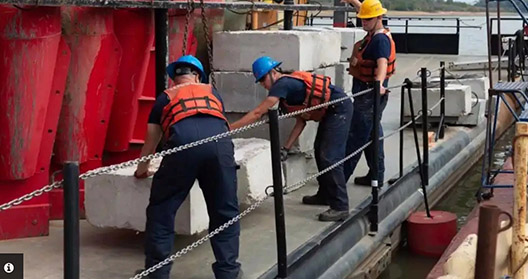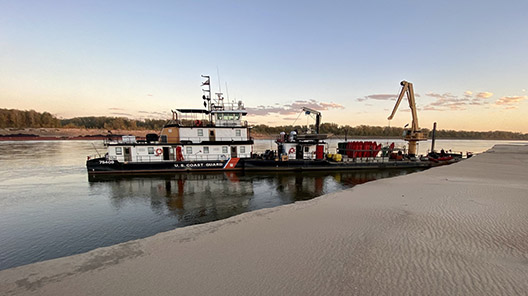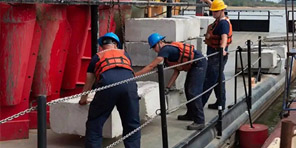By Martin Berman-Gorvine, MyCG Writer
For the Coast Guard cutter crews on the Mississippi River, the low-water crisis that threatens shipping on this vital artery of American commerce means a greatly increased workload. Yet they’re taking pride in keeping commerce – and the river’s famed barges – moving in near-impossible conditions.

For the Coast Guard cutter crews on the Mississippi River, the low-water crisis that threatens shipping means a greatly increased workload. Yet they’re taking pride in keeping commerce – and the river’s famed barges – moving in near-impossible conditions.
Droughts have created low water conditions along the Mississippi River. In some places, only the central shipping channel is still flowing. The river’s tenders have been dealing with waterway closures, vessel restrictions, and dredging operations, leading the Coast Guard’s upper and lower Mississippi River sectors to take the unusual step of setting up Marine Transportation System Recovery Units (MTSRUs) for low-water conditions.
The MTSRUs are ensuring navigational safety and protecting the environment along this mighty and vital waterway. The Mississippi, along with its tributaries, accounts for 95 percent of all inland river system tonnage and more than half of all agricultural exports from the nation’s heartland.
The unglamorous job of the cuttermen is to check that buoys are set at appropriate depths despite the constantly fluctuating water conditions. These are 500-pound buoys, around seven feet in circumference, rising about 13 feet above the water’s surface. They’re attached by chains to 1,500-pound concrete anchors.
Under normal conditions, maintaining these buoys is all in a day’s work.
But right now, the water can change from 40 feet to two feet without warning, explained Chief Petty Officer Lance Seavey, the engineering petty officer aboard the Coast Guard Cutter Kankakee.

If the buoy is too shallow, “we pull it out and find deeper water,” Seavey said. The point, he added, is to “make sure the channel in the Mississippi is deep and wide enough for barge traffic to move up and down.”
Watch the Kankakee laying buoys: https://www.dvidshub.net/video/860633/cgc-kankakee-buoys
The Kankakee sends out the small boat to do some of these surveys. Petty Officer First Class Shane Klema, a boatswain’s mate, recently travelled 50 miles on road, then another 50 miles on the river, as part of a mission to set aids to navigation (ATON) around low-water spots, like river bends.
“This is a lot of work,” he said, “but you’re able to turn around and see what you’ve done and hear what you’ve done once they open the river back up because the industry needs it. It’s rewarding.”
For Chief Petty Officer Seth Aldrich, a boatswain’s mate aboard the Kankakee, a memorable aspect of the current extended operation is “working closely with the Army Corps of Engineers at Battle Axe,” at mile marker 683 on the Mississippi River.
“We were able to moor up to them and see all that they’re doing, as well as the overall amount of work that is being put in by the Coast Guard, Army Corps and industry,” he said.
Battle Axe and the “Red Man” area at mile marker 740 have repeatedly turned into chokepoints” in the past couple of months, he said. That’s prompted the Kankakee’s crew to put Automatic Identification System (AIS) contacts, referred to as virtual aids, on the river. “The first time I’ve seen that,” Aldrich said.
“The big thing about the Mississippi is that most people don’t understand the amount of commerce that is traveling up and down the river,” Aldrich added. “Keeping that open and available for safe transit is our mission.”
Seavey has also been helping other Coast Guard cutters joining in the mission, such as the Patoka and the Chippewa. “Helping them out with any logistics that they need has been rewarding, because we have been here a little longer than they have, and them not being from this area, they need our help getting their footing,” Seavey said. “Seeing the Mississippi at record lows has been crazy, but being able to help out the industry has been great.”
“Every single day, the Coast Guard’s inland river tender fleet keeps the Marine Transportation System running smoothly. But they rarely make headlines. I’m proud to see the spotlight on our black hull fleet’s enlisted crews, who are demonstrating exceptional dedication and leadership while mitigating the impacts from historically low-water levels on the inland river system,” said Rear Adm. Richard V. Timme, the Coast Guard’s Eight District commander.
It’s worth noting that these members are working on ships that are 78 years old. The Coast Guard’s Waterways Commerce Cutter (WCC) program recently issued its first construction contract for 16 river buoy tenders and 11 inland construction tenders. These new WCCs will have greater endurance, speed and deck load capacity than their predecessors. The ships will also feature improved habitability and will accommodate mixed-gender crews.

